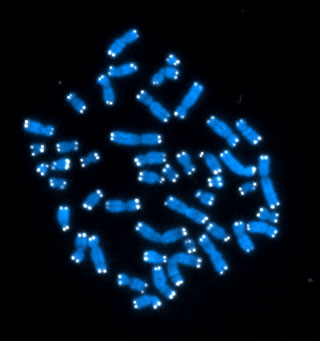
Shown above are 23 pairs of human chromosomes, with telomeres (protective DNA caps at the ends of the chromosomes) marked in white. In most human cells, telomeres become shorter with each cycle of DNA replication and cell division. The importance of telomere shortening to the process of cellular aging has been widely studied and debated. (Image by Hesed Padilla-Nash and Thomas Ried, the National Cancer Institute)
Instructor(s)
Dr. Dudley W. Lamming
Dr. Eric L. Bell
MIT Course Number
7.342
As Taught In
Fall 2011
Level
Undergraduate
Course Description
Course Features
Course Description
Aging involves an intrinsic and progressive decline in function that eventually will affect us all. While everyone is familiar with aging, many basic questions about aging are mysterious. Why are older people more likely to experience diseases like cancer, stroke, and neurodegenerative disorders? What changes happen at the molecular and cellular levels to cause the changes that we associate with old age? Is aging itself a disease, and can we successfully intervene in the aging process?
This course is one of many Advanced Undergraduate Seminars offered by the Biology Department at MIT. These seminars are tailored for students with an interest in using primary research literature to discuss and learn about current biological research in a highly interactive setting. Many instructors of the Advanced Undergraduate Seminars are postdoctoral scientists with a strong interest in teaching.


